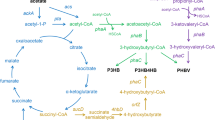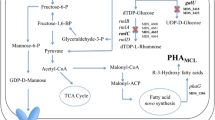Abstract
Production of medium chain length polyhydroxyalkanoate (mcl-PHA) was attempted using Pseudomonas gessardii NIBRBAC000509957, which was isolated from Sunchang, Jeollabuk-do, Republic of Korea (35°24′27.7"N, 127°09′13.0"E) and effectively utilized acetate and formate as carbon sources. We first evaluated the utilization of acetate as a carbon source, revealing optimal growth at 5 g/L acetate. Then, formate was supplied to the acetate minimal medium as a carbon source to enhance cell growth. After overexpressing the acetate and formate assimilation pathway enzymes, this strain grew at a significantly higher rate in the medium. As this strain naturally produces PHA, it was further engineered metabolically to enhance mcl-PHA production. The engineered strain produced 0.40 g/L of mcl-PHA with a biomass content of 30.43% in fed-batch fermentation. Overall, this strain can be further developed to convert acetate and formate into valuable products.





Similar content being viewed by others
References
Agnew, D. E., & Pfleger, B. F. (2013). Synthetic biology strategies for synthesizing polyhydroxyalkanoates from unrelated carbon sources. Chemical Engineering Science, 103, 58–67.
Ahmad, W., Koley, P., Dwivedi, S., Lakshman, R., Shin, Y. K., van Duin, A. C. T., Shrotri, A., & Tanksale, A. (2023). Aqueous phase conversion of CO2 into acetic acid over thermally transformed MIL-88B catalyst. Nature Communications, 14, 2821.
Al-Tamreh, S. A., Ibrahim, M. H., El-Naas, M. H., Vaes, J., Pant, D., Benamor, A., & Amhamed, A. (2021). Electroreduction of carbon dioxide into formate: A comprehensive review. ChemElectroChem, 8, 3207–3220.
Beckers, V., Poblete-Castro, I., Tomasch, J., & Wittmann, C. (2016). Integrated analysis of gene expression and metabolic fluxes in PHA-producing Pseudomonas putida grown on glycerol. Microbial Cell Factories, 15, 73.
Borrero-de Acuña, J. M., Bielecka, A., Häussler, S., Schobert, M., Jahn, M., Wittmann, C., Jahn, M., & Poblete-Castro, I. (2014). Production of medium chain length polyhydroxyalkanoate in metabolic flux optimized Pseudomonas putida. Microbial Cell Factories, 13, 88.
Borrero-de Acuña, J. M., Rohde, M., Saldias, C., & Poblete-Castro, I. (2021). Fed-Batch mcl-polyhydroxyalkanoates production in Pseudomonas putida KT2440 and ΔphaZ mutant on biodiesel-derived crude glycerol. Frontiers in Bioengineering and Biotechnology, 9, 642023.
Calzadiaz-Ramirez, L., & Meyer, A. S. (2022). Formate dehydrogenases for CO2 utilization. Current Opinion in Biotechnology, 73, 95–100.
Chang, W., Yoon, J., & Oh, M. K. (2022). Production of polyhydroxyalkanoates with the fermentation of Methylorubrum extorquens using formate as a carbon substrate. Biotechnology and Bioprocess Engineering, 27, 268–275.
Chen, J., Li, W., Zhang, Z. Z., Tang, T. W., & Li, Z. J. (2018). Metabolic engineering of Escherichia coli for the synthesis of polyhydroxyalkanoates using acetate as a main carbon source. Microbial Cell Factories, 17, 102.
Choi, S. Y., Cho, I. J., Lee, Y., Kim, Y. J., Kim, K. J., & Lee, S. Y. (2020). Microbial polyhydroxyalkanoates and nonnatural polyesters. Advanced Materials, 32, 1907138.
Chong, H. Q., Yeow, J., Wang, I., Song, H., & Jiang, R. R. (2013). Improving acetate tolerance of Escherichia coli by rewiring its global regulator cAMP receptor protein (CRP). PLoS ONE, 8, e77422.
Da Silva, D. A., Antonio, R. V., Rossi, J. M., & Pena, R. D. (2014). Production of medium-chain-length polyhydroxyalkanoate by Pseudomonas oleovorans grown in sugary cassava extract supplemented with andiroba oil. Food Science and Technology, 34, 738–745.
Fang, L. X., Fan, J., Luo, S. L., Chen, Y. R., Wang, C. Y., Cao, Y. X., & Song, H. (2021). Genome-scale target identification in Escherichia coli for high-titer production of free fatty acids. Nature Communications, 12, 4976.
Favaro, L., Basaglia, M., & Casella, S. (2019). Improving polyhydroxyalkanoate production from inexpensive carbon sources by genetic approaches: A review. Biofuels Bioproducts & Biorefining, 13, 208–227.
Felsenstein, J. (1985). Confidence limits on phylogenies: An approach using the bootstrap. Evolution, 39, 783–791.
Gumel, A. M., Annuar, M. S. M., & Chisti, Y. (2013). Recent advances in the production, recovery and applications of polyhydroxyalkanoates. Journal of Polymers and the Environment, 21, 580–605.
Hwang, H. W., Yoon, J., Min, K., Kim, M. S., Kim, S. J., Cho, D. H., Susila, H., Na, J. G., Oh, M. K., & Kim, Y. H. (2020). Two-stage bioconversion of carbon monoxide to biopolymers via formate as an intermediate. Chemical Engineering Journal, 389, 124394.
Kawanami, H., Himeda, Y., & Laurenczy, G. (2017). Formic acid as a hydrogen carrier for fuel cells toward a sustainable energy system. Advances in Inorganic Chemistry, 70, 395–427.
Kiefer, D., Merkel, M., Lilge, L., Henkel, M., & Hausmann, R. (2021). From acetate to bio-based products: Underexploited potential for industrial biotechnology. Trends in Biotechnology, 39, 397–411.
Kim, S. J., Yoon, J., Im, D. K., Kim, Y. H., & Oh, M. K. (2019). Adaptively evolved Escherichia coli for improved ability of formate utilization as a carbon source in sugar-free conditions. Biotechnology for Biofuels, 12, 207.
Kushartomo, W., & Prabowo, A. (2019). The application of sodium acetate as concrete permeability-reducing admixtures. IOP Conference Series: Materials Science and Engineering, 508, 012009.
Lee, H. M., Jeon, B. Y., & Oh, M. K. (2016). Microbial production of ethanol from acetate by engineered Ralstonia eutropha. Biotechnology and Bioprocess Engineering, 21, 402–407.
Lemos, P. C., Serafim, L. S., & Reis, M. A. M. (2004). Polyhydroxyalkanoates production by activated sludge in a SBR using acetate and propionate as carbon sources. Water Science and Technology, 50, 189–194.
Ling, C., Peabody, G. L., Salvachúa, D., Kim, Y. M., Kneucker, C. M., Calvey, C. H., Monninger, M. A., Munoz, N. M., Poirier, B. C., Ramirez, K. J., et al. (2022). Muconic acid production from glucose and xylose in Pseudomonas putida via evolution and metabolic engineering. Nature Communications, 13, 4925.
Liu, H., Chen, Y., Zhang, Y., Zhao, W., Guo, H., Wang, S., Xia, W., Wang, S., Liu, R., & Yang, C. (2022). Enhanced production of polyhydroxyalkanoates in Pseudomonas putida KT2440 by a combination of genome streamlining and promoter engineering. International Journal of Biological Macromolecules, 209, 117–124.
Liu, Y. M., Chen, S., Quan, X., & Yu, H. T. (2015). Efficient electrochemical reduction of carbon dioxide to acetate on nitrogen-doped nanodiamond. Journal of the American Chemical Society, 137, 11631–11636.
Mezzina, M. P., Manoli, M. T., Prieto, M. A., & Nikel, P. I. (2021). Engineering native and synthetic pathways in Pseudomonas putida for the production of tailored polyhydroxyalkanoates. Biotechnology Journal, 16, e2000165.
Nguyen, L. T., Mai, D. H. A., Sarwar, A., & Lee, E. Y. (2022). Reconstructing ethanol oxidation pathway in Pseudomonas putida KT2440 for bio-upgrading of ethanol to biodegradable polyhydroxybutanoates. International Journal of Biological Macromolecules, 222, 902–914.
Nwanebu, E., Omanovic, S., Hrapovic, S., Vidales, A. G., & Tartakovsky, B. (2022). Carbon dioxide conversion to acetate and methane in a microbial electrosynthesis cell employing an electrically-conductive polymer cathode modified by nickel-based coatings. International Journal of Hydrogen Energy, 47, 203–215.
Peter, S. C. (2018). Reduction of CO2 to chemicals and fuels: A solution to global warming and energy crisis. ACS Energy Letters, 3, 1557–1561.
Poblete-Castro, I., Rodriguez, A. L., Lam, C. M. C., & Kessler, W. (2014). Improved production of medium-chain-length polyhydroxyalkanoates in glucose-based fed-batch cultivations of metabolically engineered Pseudomonas putida strains. Journal of Microbiology and Biotechnology, 24, 59–69.
Preuster, P., & Albert, J. (2018). Biogenic formic acid as a green hydrogen carrier. Energy Technology, 6, 501–509.
Qiu, Y. Z., Han, J., Guo, J. J., & Chen, G. Q. (2005). Production of poly(3-hydroxybutyrate-co-3-hydroxyhexanoate) from gluconate and glucose by recombinant Aeromonas hydrophila and Pseudomonas putida. Biotechnology Letters, 27, 1381–1386.
Rajaraman, E., Agarwal, A., Crigler, J., Seipelt-Thiemann, R., Altman, E., & Eiteman, M. A. (2016). Transcriptional analysis and adaptive evolution of Escherichia coli strains growing on acetate. Applied Microbiology and Biotechnology, 100, 7777–7785.
Singh, A., Prajapati, P., Vyas, S., Gaur, V. K., Sindhu, R., Binod, P., Kumar, V., Singhania, R. R., Awasthi, M. K., Zhang, Z. Q., & Varjani, S. (2023). A comprehensive review of feedstocks as sustainable substrates for next-generation biofuels. BioEnergy Research, 16, 105–122.
Tamura, K., Stecher, G., & Kumar, S. (2021). MEGA11 molecular evolutionary genetics analysis version 11. Molecular Biology and Evolution, 38, 3022–3027.
Vigneswari, S., Noor, M. S. M., Amelia, T. S. M., Balakrishnan, K., Adnan, A., Bhubalan, K., Amirul, A. A. A., & Ramakrishna, S. (2021). Recent advances in the biosynthesis of polyhydroxyalkanoates from lignocellulosic feedstocks. Life, 11, 807.
Weisburg, W. G., Barns, S. M., Pelletier, D. A., & Lane, D. J. (1991). 16S ribosomal DNA amplification for phylogenetic study. Journal of Bacteriology, 173, 697–703.
Xu, P., Gu, Q., Wang, W. Y., Wong, L., Bower, A. G. W., Collins, C. H., & Koffas, M. A. G. (2013). Modular optimization of multi-gene pathways for fatty acids production in E. coli. Nature Communications, 4, 1409.
Yang, S., Li, S., & Jia, X. (2019). Production of medium chain length polyhydroxyalkanoate from acetate by engineered Pseudomonas putida KT2440. Journal of Industrial Microbiology and Biotechnology, 46, 793–800.
Yoon, J., Chang, W., Oh, S. H., Choi, S. H., Yang, Y. H., & Oh, M. K. (2021). Metabolic engineering of Methylorubrum extorquens AM1 for poly (3-hydroxybutyrate-co-3-hydroxyvalerate) production using formate. International Journal of Biological Macromolecules, 177, 284–293.
Zhang, X., Lin, Y. N., Wu, Q., Wang, Y., & Chen, G. Q. (2020). Synthetic biology and genome-editing tools for improving PHA metabolic engineering. Trends in Biotechnology, 38, 689–700.
Zhang, Z., Xi, D., Ren, Z., & Li, J. (2023). A carbon-efficient bicarbonate electrolyzer. Cell Reports Physical Science, 4, 101662.
Zhou, W., Bergsma, S., Colpa, D. I., Euverink, G. J. W., & Krooneman, J. (2023). Polyhydroxyalkanoates (PHAs) synthesis and degradation by microbes and applications towards a circular economy. Journal of Environmental Management, 341, 118033.
Zhu, Y., Ai, M., & Jia, X. (2022). Optimization of a two-Species microbial consortium for improved mcl-PHA production from glucose-xylose mixtures. Frontiers in Bioengineering and Biotechnology, 9, 794331.
Acknowledgements
This work was supported by a grant from the National Institute of Biological Resources (NIBR), funded by the Ministry of Environment (MOE) of the Republic of Korea (NIBR202327103).
Author information
Authors and Affiliations
Contributions
Woo Young Kim: Conceptualization, methodology, validation, formal analysis, investigation, data curation, writing the original draft, and visualization. Hye-rin Seo, Jong-Geol Kim: Conceptualization, methodology, and writing. Seung-Jin Kim, Yoonyong Yang, Jong Seok Lee, Moonsuk Hur, Byoung-Hee Lee: Conceptualization, methodology, writing, and reviewing. Min-Kyu Oh: Conceptualization, methodology, validation, writing–review and editing, supervision, project administration, and funding acquisition.
Corresponding author
Ethics declarations
Conflict of Interest
The authors declare no competing financial interests.
Rights and permissions
Springer Nature or its licensor (e.g. a society or other partner) holds exclusive rights to this article under a publishing agreement with the author(s) or other rightsholder(s); author self-archiving of the accepted manuscript version of this article is solely governed by the terms of such publishing agreement and applicable law.
About this article
Cite this article
Kim, W.Y., Kim, SJ., Seo, Hr. et al. Medium Chain Length Polyhydroxyalkanoate Production by Engineered Pseudomonas gessardii Using Acetate-formate as Carbon Sources. J Microbiol. (2024). https://doi.org/10.1007/s12275-024-00136-x
Received:
Revised:
Accepted:
Published:
DOI: https://doi.org/10.1007/s12275-024-00136-x




